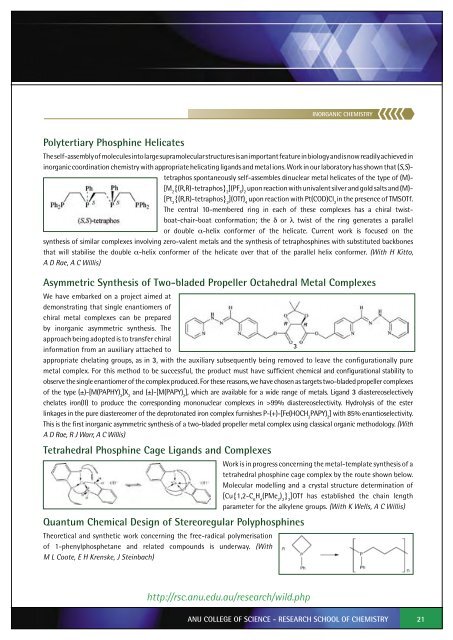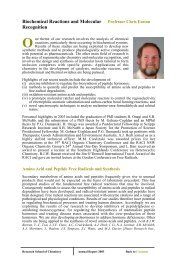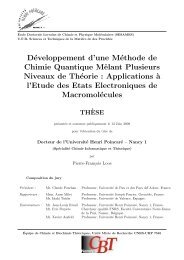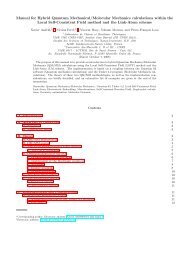View 2005 Report - RSC - Australian National University
View 2005 Report - RSC - Australian National University
View 2005 Report - RSC - Australian National University
You also want an ePaper? Increase the reach of your titles
YUMPU automatically turns print PDFs into web optimized ePapers that Google loves.
INORGANIC CHEMISTRY<br />
Polytertiary Phosphine Helicates<br />
The self-assembly of molecules into large supramolecular structures is an important feature in biology and is now readily achieved in<br />
inorganic coordination chemistry with appropriate helicating ligands and metal ions. Work in our laboratory has shown that (S,S)-<br />
tetraphos spontaneously self-assembles dinuclear metal helicates of the type of (M)-<br />
[M 2<br />
{(R,R)-tetraphos} 2<br />
](PF 6<br />
) 2<br />
upon reaction with univalent silver and gold salts and (M)-<br />
[Pt 2<br />
{(R,R)-tetraphos} 2<br />
](OTf) 4<br />
upon reaction with Pt(COD)Cl 2<br />
in the presence of TMSOTf.<br />
The central 10-membered ring in each of these complexes has a chiral twistboat-chair-boat<br />
conformation; the δ or λ twist of the ring generates a parallel<br />
or double α-helix conformer of the helicate. Current work is focused on the<br />
synthesis of similar complexes involving zero-valent metals and the synthesis of tetraphosphines with substituted backbones<br />
that will stabilise the double α-helix conformer of the helicate over that of the parallel helix conformer. (With H Kitto,<br />
A D Rae, A C Willis)<br />
Asymmetric Synthesis of Two-bladed Propeller Octahedral Metal Complexes<br />
We have embarked on a project aimed at<br />
demonstrating that single enantiomers of<br />
chiral metal complexes can be prepared<br />
by inorganic asymmetric synthesis. The<br />
approach being adopted is to transfer chiral<br />
3<br />
information from an auxiliary attached to<br />
appropriate chelating groups, as in 3, with the auxiliary subsequently being removed to leave the configurationally pure<br />
metal complex. For this method to be successful, the product must have sufficient chemical and configurational stability to<br />
observe the single enantiomer of the complex produced. For these reasons, we have chosen as targets two-bladed propeller complexes<br />
of the type (±)-[M(PAPHY) 2<br />
]X 2<br />
and (±)-[M(PAPY) 2<br />
], which are available for a wide range of metals. Ligand 3 diastereoselectively<br />
chelates iron(II) to produce the corresponding mononuclear complexes in >99% diastereoselectivity. Hydrolysis of the ester<br />
linkages in the pure diastereomer of the deprotonated iron complex furnishes P-(+)-[Fe(HOCH 2<br />
PAPY) 2<br />
] with 85% enantioselectivity.<br />
This is the first inorganic asymmetric synthesis of a two-bladed propeller metal complex using classical organic methodology. (With<br />
A D Rae, R J Warr, A C Willis)<br />
Tetrahedral Phosphine Cage Ligands and Complexes<br />
Quantum Chemical Design of Stereoregular Polyphosphines<br />
Theoretical and synthetic work concerning the free-radical polymerisation<br />
of 1-phenylphosphetane and related compounds is underway. (With<br />
M L Coote, E H Krenske, J Steinbach)<br />
Work is in progress concerning the metal-template synthesis of a<br />
tetrahedral phosphine cage complex by the route shown below.<br />
Molecular modelling and a crystal structure determination of<br />
[Cu{1,2-C 6<br />
H 4<br />
(PMe 2<br />
) 2<br />
} 2<br />
]OTf has established the chain length<br />
parameter for the alkylene groups. (With K Wells, A C Willis)<br />
http://rsc.anu.edu.au/research/wild.php<br />
ANU COLLEGE OF SCIENCE - RESEARCH SCHOOL OF CHEMISTRY<br />
21






